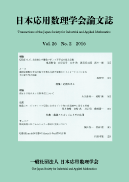
- Issue 4 Pages 285-
- Issue 3 Pages 239-
- Issue 2 Pages 66-
- Issue 1 Pages 1-
- |<
- <
- 1
- >
- >|
-
Kazufumi Ozawa, Shinsuke Nakamura, Chiaki Hirota2017 Volume 27 Issue 2 Pages 66-83
Published: 2017
Released on J-STAGE: June 25, 2017
JOURNAL FREE ACCESSBinary powering (or repetitive squaring) is an efficient algorithm for computing xp, when p is a positive integer. The time complexity of the algorithm is O(log p). However, the problem of computing xp for a floating-point number x is an unstable problem, whatever the algorithm is used. An improved binary powering algorithm is proposed for accurately computing the power of floating-point numbers, for the case that x = 1 + d, (|d| ≪ 1). This algorithm is particularly useful for multilength floating-point arithmetic. Numerical experiments which confirm the validity of the algorithm are given.
View full abstractDownload PDF (1557K)
-
Daijiro Sonoda, Yoshiharu Ohi, Tomoya Tatsuno2017 Volume 27 Issue 2 Pages 84-111
Published: 2017
Released on J-STAGE: June 25, 2017
JOURNAL FREE ACCESSAbstract. Based on the Perfectly Matched Layer which is often used in wave equations, a fictitious absorbing layer is implemented in the nonlinear vorticity equations, a reduced set of fluid equations. It is shown that the fictitious absorbing layer is effective for the vorticity equations by introducing residual ratio for the theoretical guidance, and by making finitedifference numerical simulations of two examples, translational motion of vorticity and von Karman vortex street. Optimal absorbing coefficient is not determined merely by the theoretical estimate of the residual ratio, but depends on both grid size and accuracy of discretization.
View full abstractDownload PDF (3292K)
-
Sonomi Kawasaki, Takaharu Yaguchi, Kouhei Masumoto, Narihiko Kondo, Sh ...2017 Volume 27 Issue 2 Pages 112-146
Published: 2017
Released on J-STAGE: June 25, 2017
JOURNAL FREE ACCESSAbstract. The number of elderly persons dying alone and filed requests to search for missing persons who disappeared due to dementia-related wandering have increased. In order to solve these problems, the mutual support and cooperation of community residents are essential. In this research, we develop a method of statistical testing to evaluate a program to promote communication among residents, of which aim is forming community networks.
View full abstractDownload PDF (1176K) -
Azuma Taguchi, Mizuyo Takamatsu2017 Volume 27 Issue 2 Pages 147-161
Published: 2017
Released on J-STAGE: June 25, 2017
JOURNAL FREE ACCESSAbstract. This article investigates purchase behavior of train commuters at kiosks in stations. Commuters make a decision about whether to stop at a kiosk, based on the number of kinds of goods in the kiosk, expected queuing time, and so on. We provide a common explanation of purchase behavior of commuters at four kinds of kiosks from a viewpoint of congestion. Moreover, we present a mathematical model to estimate every 15 minutes how many commuters stop at a kiosk.
View full abstractDownload PDF (1099K)
-
Naohiro Fukuda, Tamotu Kinoshita2017 Volume 27 Issue 2 Pages 162-185
Published: 2017
Released on J-STAGE: June 25, 2017
JOURNAL FREE ACCESSAbstract. The Stömberg wavelet was constructed as the first smooth orthonormal wavelet. In this paper, by reconsidering the derivation of the construction we produce an analogue type of wavelet. The Stömberg wavelet of order 4 and its analogue type correspond to the B-spline N4(x) which is useful in industrial application. We also investigate the symmetricity property.
View full abstractDownload PDF (1070K)
-
Miyori Shirasuna, Zhong Zhang, Tetsuo Miyake, Takuma Akiduki, Hiroshi ...2017 Volume 27 Issue 2 Pages 186-215
Published: 2017
Released on J-STAGE: June 25, 2017
JOURNAL FREE ACCESSAbstract. In this paper, we propose the calculation reduction method for a continuous wavelet coefficient using a wavelet, whose support in the frequency domain is compact, and apply it to the continuous wavelet transform using the approximate Gabor wavelet, whose support in the frequency domain is compacted by the appropriate band-limiting filter.
View full abstractDownload PDF (1182K) -
Nobuko Ikawa, Akira Morimoto, Ryuichi Ashino2017 Volume 27 Issue 2 Pages 216-238
Published: 2017
Released on J-STAGE: June 25, 2017
JOURNAL FREE ACCESSAbstract. Auditory Brainstem Response (ABR) is one of important indicators for the human objective audiometry. ABR has been obtained by averaging of many waveforms evoked as brain responses during 10 msec from input sound stimulation to the ears. The conventional method sometimes needs about two thousand waveforms for averaging. We propose a novel quick diagnosis by applying the discrete stationary wavelet analysis (SWA) to the averaging waveforms. For the fast ABR, our method only needs ten waveforms. Asa spontaneous electroencephalographic synchronization signal, we analyze the slow ABR using the Kuramoto model.
View full abstractDownload PDF (1788K)
- |<
- <
- 1
- >
- >|